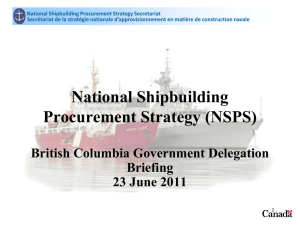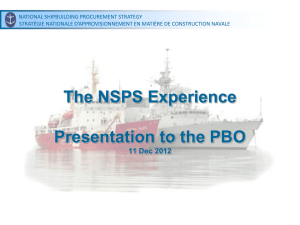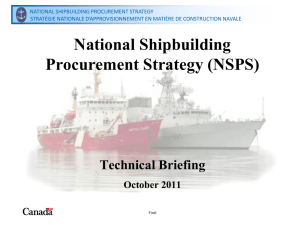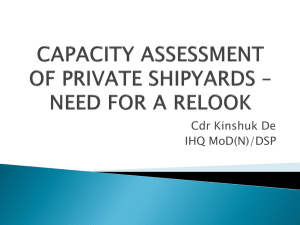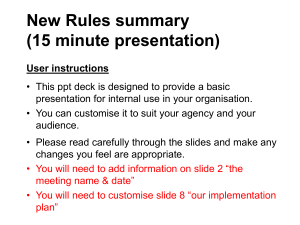PowerPoint Version
advertisement
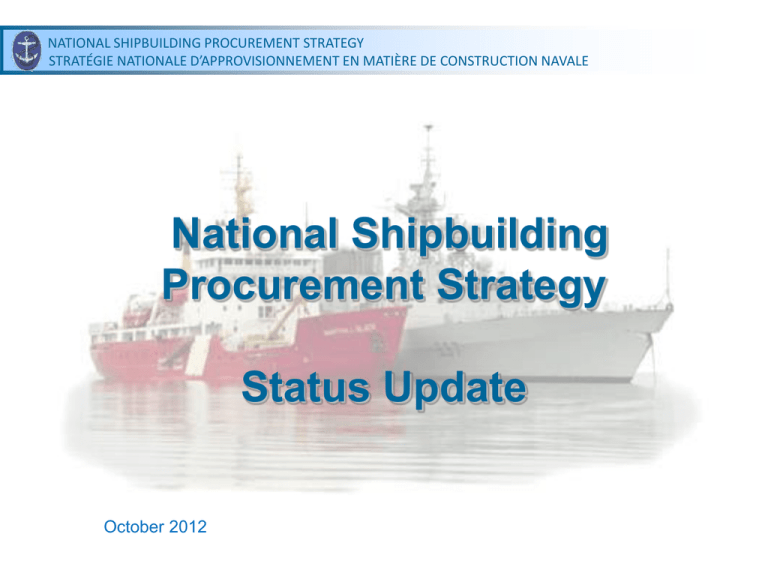
NATIONAL SHIPBUILDING PROCUREMENT STRATEGY STRATÉGIE NATIONALE D’APPROVISIONNEMENT EN MATIÈRE DE CONSTRUCTION NAVALE National Shipbuilding Procurement Strategy Status Update October 2012 NATIONAL SHIPBUILDING PROCUREMENT STRATEGY STRATÉGIE NATIONALE D’APPROVISIONNEMENT EN MATIÈRE DE CONSTRUCTION NAVALE The Environment • Over the next 30 years, Canada will need to renew the Royal Canadian Navy and Coast Guard fleets to ensure operations can continue in all of Canada’s waters, including the Arctic. • Canadian Shipbuilding Policy states that the Government will procure, repair and refit vessels in Canada subject to operational requirements and the continued existence of a competitive domestic marketplace. • Canada’s previous approach to building ships was project-by-project with no long term strategy resulting in a “boom” and “bust” cycle. 2 NATIONAL SHIPBUILDING PROCUREMENT STRATEGY STRATÉGIE NATIONALE D’APPROVISIONNEMENT EN MATIÈRE DE CONSTRUCTION NAVALE What is NSPS? Developing the Strategy Selecting the Shipyards Establishing the Relationship Preparing the Yards & Finalizing the Designs Constructing the Ships The Strategy was developed and is being implemented to: • Recognize the strategic importance of a strong domestic shipbuilding industry • Support the industry’s sustainable development through a long-term approach to federal procurement • Ensure that Canada’s needs for large vessels can be met in a timely and affordable manner • Seek long-term benefits over short-term fixes 3 NATIONAL SHIPBUILDING PROCUREMENT STRATEGY STRATÉGIE NATIONALE D’APPROVISIONNEMENT EN MATIÈRE DE CONSTRUCTION NAVALE Developing the Strategy • Canada launched broad consultations with industry during summer 2009 to inform the strategy development • Industry expressed a high level of support for the development of a long-term strategy • Most respondents supported establishing a strategic relationship with two shipyards to build all large ships • Culminated in June 3, 2010 announcement 4 NATIONAL SHIPBUILDING PROCUREMENT STRATEGY STRATÉGIE NATIONALE D’APPROVISIONNEMENT EN MATIÈRE DE CONSTRUCTION NAVALE Elements of NSPS 1. Select 2 Canadian shipyards to build Canada’s large vessels, one to build Combat Vessels and the other Non-Combat Vessels 2. Compete smaller vessels procurements amongst Canadian shipyards other than the 2 selected yards and their affiliates 3. Repair, maintenance and refit – Business as usual; competitive procurements 5 NATIONAL SHIPBUILDING PROCUREMENT STRATEGY STRATÉGIE NATIONALE D’APPROVISIONNEMENT EN MATIÈRE DE CONSTRUCTION NAVALE Selecting the Shipyard NSPS Industry Day for Canadian shipyards interested in building large ships • August 2010 Issue of the Solicitation of Interest and Qualification to all Canadian shipyards • September 2010 Issue of the Request for Proposals to qualified bidders • Issued Feb 7, 2011, Closed July 21, 2011 Evaluation of Proposals received from the bidders • Selection announced October 19, 2011 6 NATIONAL SHIPBUILDING PROCUREMENT STRATEGY STRATÉGIE NATIONALE D’APPROVISIONNEMENT EN MATIÈRE DE CONSTRUCTION NAVALE Successful Attributes • Engagement • Leadership / Governance / Decision-Making • Use of Independent Third Parties 7 NATIONAL SHIPBUILDING PROCUREMENT STRATEGY STRATÉGIE NATIONALE D’APPROVISIONNEMENT EN MATIÈRE DE CONSTRUCTION NAVALE Engagement • Extensive consultation with bidders took place on the concept, the requirements and the evaluation process and criteria • The procurement process was driven by transparency and collaboration • Pro-active communication throughout the procurement process 8 NATIONAL SHIPBUILDING PROCUREMENT STRATEGY STRATÉGIE NATIONALE D’APPROVISIONNEMENT EN MATIÈRE DE CONSTRUCTION NAVALE Governance • No Political Involvement • Deputy Ministers’ Governance Committee made key decisions in an open and transparent manner • Unique dispute avoidance and issue resolution processes – Used the governance structure to resolve issues – No lobbyists – No legal disputes or challenges of the process or the results 9 NATIONAL SHIPBUILDING PROCUREMENT STRATEGY STRATÉGIE NATIONALE D’APPROVISIONNEMENT EN MATIÈRE DE CONSTRUCTION NAVALE Use of 3rd Parties • Internationally recognized experts were engaged to: – Monitor Fairness – Assess Capability and Performance Benchmarking – Provide Expert Advice – Assess Financial Proposals • Third parties: – Attended governance meetings to answer DM & ADM questions directly – Provided written attestations that processes, actions and decisions were fair, reasonable and prudent 10 NATIONAL SHIPBUILDING PROCUREMENT STRATEGY STRATÉGIE NATIONALE D’APPROVISIONNEMENT EN MATIÈRE DE CONSTRUCTION NAVALE Other Attributes • Simplified Solicitation of Interest & Qualification • Value Proposition • Umbrella Agreements • Keeping the results secret until the shipyards were informed • Communications 11 NATIONAL SHIPBUILDING PROCUREMENT STRATEGY STRATÉGIE NATIONALE D’APPROVISIONNEMENT EN MATIÈRE DE CONSTRUCTION NAVALE The New Approach to Procurement • Listen to those with a stake in the process - clients and suppliers in equal measure – Suppliers often have valuable ideas about how to efficiently supply the government with what it needs • Adopt a governance or decision-making process that allows for real business choices to be made by both clients and procurement staff with direct input from suppliers – Make sure there is a robust issue resolution process to address any concerns and manage risks in a timely manner • Seek advice and input from those who are knowledgeable or expert but do not have a stake in the process 12 NATIONAL SHIPBUILDING PROCUREMENT STRATEGY STRATÉGIE NATIONALE D’APPROVISIONNEMENT EN MATIÈRE DE CONSTRUCTION NAVALE Establishing the Relationships • Long-term nature of the strategic relationships demanded a strong foundation • Canada and the two selected shipyards signed Umbrella Agreements in February 2012 • The Umbrella Agreements are long-term strategic sourcing agreements that contain the framework for business and relationship management 13 NATIONAL SHIPBUILDING PROCUREMENT STRATEGY STRATÉGIE NATIONALE D’APPROVISIONNEMENT EN MATIÈRE DE CONSTRUCTION NAVALE Preparing the Yards & Finalizing the Designs • In order to build the ships efficiently the yards need to modernize their infrastructure – An independent 3rd party expert has defined the required Target State and will assess the shipyard’s progress in attaining it – Infrastructure upgrades are being done at no cost to Canada • Initial ships in both Combat and Non-Combat packages have designs that must be finalized for production of the vessels – Shipyards need to review and finalize designs – Consultations with shipyards have lead to the decision to proceed on a “Design then Build” approach • No design work done yet for Canadian Surface Combatants 14 NATIONAL SHIPBUILDING PROCUREMENT STRATEGY STRATÉGIE NATIONALE D’APPROVISIONNEMENT EN MATIÈRE DE CONSTRUCTION NAVALE A Phased Approach to Shipbuilding Contracts • Contracting with shipyards to build ships will generally take place in three phases: – Ancillary contracts – understand the requirement and the initial design – Production / Construction Engineering contracts – mature the design so it is ready to be built – Construction contracts to build the ships • The establishment of the timelines for the phases is part of the negotiations with the shipyards • The phased approach provides less risk and will improve the efficiency of the shipbuilding process • Procurement strategy for the design, development and integration of the Canadian Surface Combatant will be determined following industry engagement 15 NATIONAL SHIPBUILDING PROCUREMENT STRATEGY STRATÉGIE NATIONALE D’APPROVISIONNEMENT EN MATIÈRE DE CONSTRUCTION NAVALE Benefits of “Design then Build” • Collaborative/Iterative understanding of requirements • Furthering ship Design to Production Level Drawings before Construction Contract • Design/Cost Tradeoffs before Construction Contract • Simulation & Modeling to attain cost fidelity before Construction Contract • Risk mitigation & appropriate risk sharing 16 NATIONAL SHIPBUILDING PROCUREMENT STRATEGY STRATÉGIE NATIONALE D’APPROVISIONNEMENT EN MATIÈRE DE CONSTRUCTION NAVALE Ship Construction Contracts • These contracts will be: – Negotiated in accordance with the rules established in the Umbrella Agreements – Subject to separate Government approval – Used by the shipyard to deliver the value proposition commitments and capability improvement commitments of the Umbrella Agreements • Current plans show construction of first NonCombat ship (Offshore Fisheries Science Vessels) beginning in 2013 and the first Combat ship (Arctic/Offshore Patrol Vessels) beginning in 2015 17 NATIONAL SHIPBUILDING PROCUREMENT STRATEGY STRATÉGIE NATIONALE D’APPROVISIONNEMENT EN MATIÈRE DE CONSTRUCTION NAVALE Opportunities for Broader Marine Industry Combat Systems Auxiliaries Hull Outfit and Furnishing Propulsion and Electrical • Warship construction provides work to a broad spectrum of the marine industry, much of it high tech • Shipyards need to bring along partners / suppliers to increase the Canadian participation in projects • Equipment represents a significant portion of the ship construction cost, thus suppliers will play an important role • Components sourced offshore will be matched dollar for dollar by IRBs 18 NATIONAL SHIPBUILDING PROCUREMENT STRATEGY STRATÉGIE NATIONALE D’APPROVISIONNEMENT EN MATIÈRE DE CONSTRUCTION NAVALE Current Status Summary • Shipyards have: – Hired senior staff including engineers, managers and production specialists – Progressed with their plans to improve their physical facilities • Canada has: – Been actively maturing its ship requirements – Reviewing its processes to ensure momentum is maintained – Been in continuous communications with the shipyards on the way ahead – Hosted supplier engagement events across the country to introduce companies to the shipyards • The Broader Marine Industry is – Participating in supplier engagement events – Preparing for supplier and sub-contracting opportunities 19 NATIONAL SHIPBUILDING PROCUREMENT STRATEGY STRATÉGIE NATIONALE D’APPROVISIONNEMENT EN MATIÈRE DE CONSTRUCTION NAVALE Continuing Industry Engagement • Canada continues to recognize the value of early engagement with industry before decisions are made • Upcoming industry engagements this fall will include: – Canadian Surface Combatants • Strategy for warship design, development and integration – In Service Support for AOPS & JSS – Small Ship requirement – DND Large Tugs 20 NATIONAL SHIPBUILDING PROCUREMENT STRATEGY STRATÉGIE NATIONALE D’APPROVISIONNEMENT EN MATIÈRE DE CONSTRUCTION NAVALE Conclusion • We are 1 year into a 30 year program • Much has been accomplished • The shipbuilding process is complex – Need to get designs and production details right BEFORE cutting steel – Need to work with shipyards to ensure they are ready to build ships efficiently and to avoid boom and bust • We’re on track to replace Canada’s large ships 21
